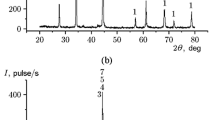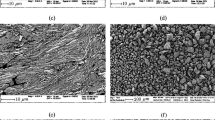Abstract
The effects of gravity on the combustion characteristics and microstructure of metal-ceramic composites (HfB2/Al and Ni3Ti/TiB2 systems) were studied under both normal and low gravity conditions. Under normal gravity conditions, pellets were ignited in three orientations relative to the gravity vector. Low gravity combustion synthesis (SHS) was carried out on a DC-9 aircraft at the NASA-Lewis Research Center. It was found that under normal gravity conditions, both the combustion temperature and wave velocity were highest when the pellet was ignited from the bottom orientation; i.e., the wave propagation direction was directly opposed to the gravitational force. The SHS of 70 vol pct Al (in the Al-HfB2 system) was changed from unstable, slow, and incomplete when ignited from the top to unstable, faster, and complete combustion when ignited from the bottom. The hydrostatic force (height × density × gravity) in the liquid aluminum was thought to be the cause of formation of aluminum nodules at the surface of the pellet. The aluminum nodules that were observed on the surface of the pellet when reacted under normal gravity were totally absent for reactions conducted under low gravity. Buoyancy of the TiB2 particles and sedimentation of the Ni3Ti phase were observed for the Ni3Ti/TiB2 system. The possibility of liquid convective flow at the combustion front was also discussed. Under low gravity conditions, both the combustion temperature and wave velocity were lower than those under normal gravity. The distribution of the ceramic phase, i.e., TiB2 or HfB2, in the intermetallic (Ni3Ti) or reactive (Al) matrix was more uniform.
Similar content being viewed by others
References
H.C. Yi, T.C. Woodger, J.Y. Guigné, and J.J. Moore: Metall. Mater. Trans. B, 1998, vol. 29B, pp. 867–75.
H.C. Yi, T.C. Woodger, J.Y. Guigné, and J.J. Moore: Metall. Mater. Trans. B, 1998, vol. 29B, pp. 877–87.
O. Ostrach: Ann. Rev. Fluid Mech., 1982, vol. 14, pp. 313–45.
L. Froyen and A. Deruyttere: Proc. 5th Eur. Symp. on Materials Sciences under Microgravity, T. Guyenne and J.J. Hunt, eds., Schloss Elmau, Germany, 1984, pp. 69–78.
S.C. Sharma, P.R. Narayanan, P.P. Sinha, K.V. Nagarajan: J. Mater. Sci., 1994, vol. 29, pp. 5719–24.
A.S. Steinburg, V.P. Shcherbakov, V.M. Martynov, M.Z. Mukhoyan, and A.G. Merzhanov: Sov. Phys. Dokl., 1991, vol. 36 (5), pp. 385–87.
J.J. Moore, D.W. Readey, F.J. Feng, K. Monroe, and B. Mishra: J. Met., 1994, Nov., pp. 72–78.
H.C. Yi, A. Varma, A.S. Rogachev, and P.J. McGinn: Ind. Eng. Chem. Res., 1996, vol. 35 (9), pp. 2982–85.
H.C. Yi and J.J. Moore: J. Mater. Sci., 1990, vol. 25, pp. 1159–68.
Author information
Authors and Affiliations
Rights and permissions
About this article
Cite this article
Yi, H.C., Guigné, J.Y., Woodger, T.C. et al. The effect of gravity on the combustion synthesis of metal-ceramic composites. Metall Mater Trans B 29, 889–897 (1998). https://doi.org/10.1007/s11663-998-0148-1
Received:
Issue Date:
DOI: https://doi.org/10.1007/s11663-998-0148-1




